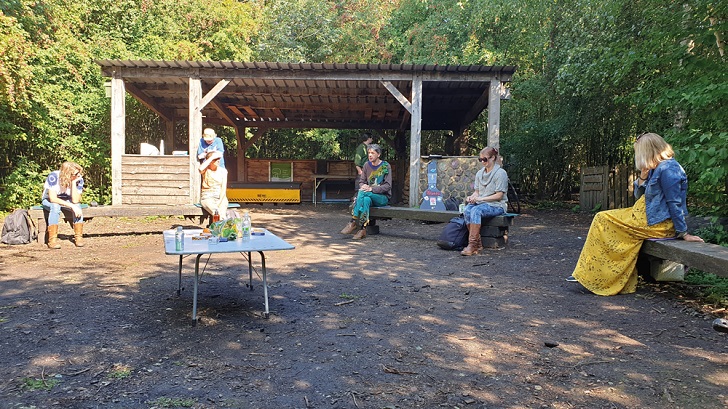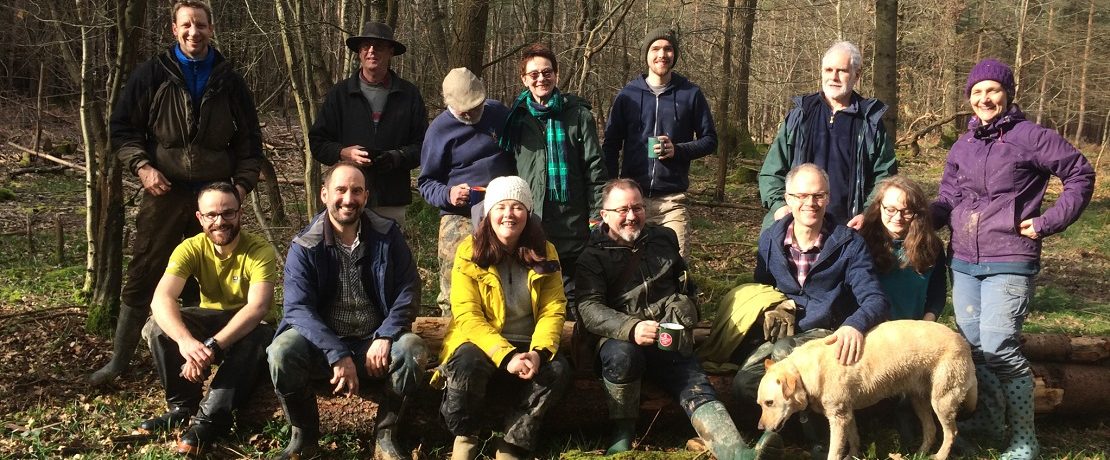Celebrating community woodland
Our forests and woods are special places – and community woodlands offer us unique opportunities to gather for companionship, solace and meaningful work, says Robin Walter.
The wood that does takeaways
You can really get down to some hands-on work at Spud Wood in Lymm, Cheshire. Planted on a former potato field around 1998, this green space was part of the Woodland Trust’s ‘Woods on Your Doorstep’ project to mark the millennium.
The local community was involved from the outset, as Nick Storer, who was also there at the beginning, explains: ‘The village got together to raise matched funds for the project,’ he recalls. ‘The kids came up with the name “Spud Wood”. Not everyone liked it, but it stuck!’
There are many such woods across the country, but what makes Spud Wood rather special is its ‘woodland allotment’ scheme, by which the Friends of Spud Wood (FoSW) can cut and remove their own firewood.
‘The wood was originally planted in quite close rows, over 18 hectares,’ explains Nick. ‘Now there is an opportunity to thin out the trees, to give the better stems more space.’ This removal, by about 40 “allotmenteers” sharing some 25 allotments, is carefully controlled by the Woodland Trust site manager.

‘Our volunteer work was stopped completely last March as the lockdown was announced, leaving the hedge half cut, and a lot of cut wood lying around where we’d been coppicing and hedgelaying,’ says Nick. ‘The cut branches were promptly turned into dens by the kids!’
Other activities have included tree planting days for local children, to fill some of the gaps left by felling. This is also a chance to widen the species mix to make the wood more diverse and resilient.
‘The wood became incredibly popular during the lockdown,’ says Nick. ‘And it has been ever since, especially with dog walkers, and people discovering the wood and travelling from Altrincham, and further, to visit.’
Restoring ancient woodland
Community woodlands are not all small pockets tucked away, or newly planted projects. Near Lewes in East Sussex, one community group has taken on the management of a 171-acre wood dating from medieval times.
Vert Woods and is part of one of the largest tracts of ancient woodland in the Low Weald of Sussex. Divided up for sale in the 1960s, the largest remaining piece of the woods came onto the market again in 2016.
‘Rather than let the wood become still further fragmented, we wondered how we could secure it for community use,’ says Marina Robb, co-chair of the community benefit society caring for the woodland. ‘To our joy, a local benefactor stepped up, bought the wood, and now leases it to us for a peppercorn rent.’
Vert Woods is now part of the newly coined ‘Laughton Greenwood’, under the management of the society, which runs all kinds of events to connect people with nature.

Ancient woodland is special because it retains undisturbed forest soils that support unique ground flora and wildlife. Here at Vert Woods you can find wild service trees and a host of other ancient woodland indicator species such as bluebell, anemone, butcher’s broom and yellow archangel.
Unfortunately, a lot of this native woodland was planted over in the 1960s with commercial Scots pine and Corsican pine. One of the main tasks for the society is to thin out the conifers and restock with native broadleaf trees appropriate to the area – namely oak, birch, hazel and hornbeam.

Laughton Greenwood also has much to offer the wider community, helping Year 9 students facing exclusion; children and young people accessing mental health services; and people with dementia. ‘We also run community events,’ says Marina. ‘Like the popular new year walk, bird-spotting and a project building “leaky dams” to slow the flow of floodwaters.’
A wild oasis
Set in the very centre of Leamington Spa, Foundry Wood used to be railway sidings next to the Ford motor factory. Since the 1960s, the land had been left undisturbed (some might say derelict) and it returned to its natural state as woodland – mostly self-sown hawthorn and sycamore, with a few mature trees on the edges.
For 60 years this triangle of land, barely two acres, had been quietly rewilding; reclothing itself in a green mantle of trees and shrubs, and gathering wild creatures into its fold.
Then in 2011, the community organisation ARC (Achieving Results in Communities) engaged with the owner and local people to open up this neglected space to promote wildlife and environmental education. They removed rubbish, made paths, dug a pond and constructed an outdoor classroom.
Now this little triangle of scrubby woodland is a magnet for community activities, from toddler groups to mental health drop-ins and Forest Schools to choirs.

Kath Pasteur, one of the organisers, has found the toddler group ‘a lifeline’ when many of the other local facilities for kids have been closed: ‘I have been able to meet other parents, at a distance, and our kids can go on walks, toast marshmallows and even hunt round the woods for ingredients for a witch’s cauldron!’
Before coronavirus, the eco-therapy group for mental health would attract 30-plus people over the course of the day. With the sessions having to move online, the absence of actually meeting in the woods has been keenly felt.
Kath hopes the wood will gradually be able to return to normal this summer: ‘The pandemic has had a profound impact on mental health and we expect to be busier than ever as we come out of lockdown,’ she says.
Foundry Wood is one wild oasis where people can gather to work it all out. The same could be said for all these woods – places that only work as community woodlands because people have stepped up to make them happen.
Robin Walter is a forester and writer based in Dorset. His work seeks to restore the web of life, and our place in it, starting with trees – as described in his book Living With Trees (Little Toller Books).
A version of this article was originally published in CPRE’s award-winning magazine, Countryside Voices. You’ll have Countryside Voices sent to your door three times a year, as well as access to other benefits including discounts on attraction visits and countryside kit from major high street stores when you join as a CPRE member. Join us now.









